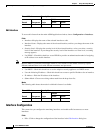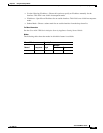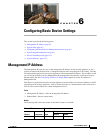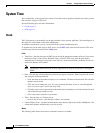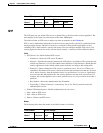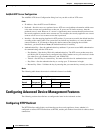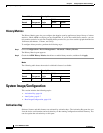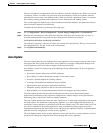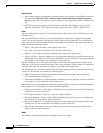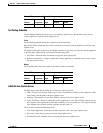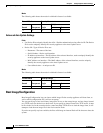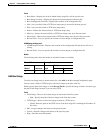
6-4
Cisco ASDM User Guide
OL-16647-01
Chapter 6 Configuring Basic Device Settings
Configuring Advanced Device Management Features
Add/Edit NTP Server Configuration
The Add/Edit NTP Server Configuration dialog box lets you add or edit an NTP server.
Fields
• IP Address—Sets the NTP server IP address.
• Preferred—Sets this server as a preferred server. NTP uses an algorithm to determine which server
is the most accurate and synchronizes to that one. If servers are of similar accuracy, then the
preferred server is used. However, if a server is significantly more accurate than the preferred one,
the security appliance uses the more accurate one. For example, the security appliance uses a more
accurate server over a less accurate server that is preferred.
• Interface—Sets the outgoing interface for NTP packets, if you want to override the default interface
according to the routing table. The system does not include any interfaces, so it uses the admin
context interfaces. If you intend to change the admin context (thus changing the available
interfaces), you should choose None (the default interface) for stability.
• Authentication Key—Sets the authentication key attributes if you want to use MD5 authentication
for communicating with the NTP server.
–
Key Number—Sets the key ID for this authentication key. The NTP server packets must also
use this key ID. If you previously configured a key ID for another server, you can select it in the
list; otherwise, type a number between 1 and 4294967295.
–
Trusted—Sets this key as a trusted key. You must select this box for authentication to work.
–
Key Value—Sets the authentication key as a string up to 32 characters in length.
–
Reenter Key Value—Validates the key by ensuring that you enter the key correctly two times.
Modes
The following table shows the modes in which this feature is available:
Configuring Advanced Device Management Features
The following sections describe how to configure the items in the Advanced section.
Configuring HTTP Redirect
The HTTP Redirect table displays each interface on the security appliance, shows whether it is
configured to redirect HTTP connections to HTTPS, and the port number from which it redirects those
connections.
Firewall Mode Security Context
Routed Transparent Single
Multiple
Context System
• • •— •



